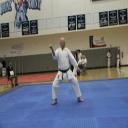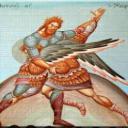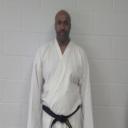Yahoo Answers is shutting down on May 4th, 2021 (Eastern Time) and beginning April 20th, 2021 (Eastern Time) the Yahoo Answers website will be in read-only mode. There will be no changes to other Yahoo properties or services, or your Yahoo account. You can find more information about the Yahoo Answers shutdown and how to download your data on this help page.
Trending News
10 Answers
- callsignfuzzyLv 77 years ago
I was dubious the second I saw the hakama...
I think seeing this application is like seeing shapes in the clouds. I'm cool with the throw, but putting this into historical context, I don't think that was what the originators had in mind. Complex ground work (a compound hold in this case) doesn't work well for either civilian self-defense or for military unarmed combat. Works pretty well for sport grappling contests that allow for protracted ground work (actually a rather recent thing) or to a lesser degree, for an authority figure who's trying to restrain someone.
Of course, Anko Itosu is credited with developing the Pinan/Heian series, and he was more interested in karate as "physical culture" than self-defense. It's possible there IS no martial application.
Edit: "kata is meant to be a manual but not meant to have one application even though the create has set in his own mind his bunkai, part of the bunkai is meant to be discovered by the practitioner"
Says who? Not rhetorical, where did this idea come from?
Edit 2: Any Japanese or Okinawan sources? I'm wondering if this idea came from a bunch of people (mostly Westerners) not knowing the applications of kata, and inferring that the moves MUST be open to interpretation. Or (referencing "Karate Masters" by Jose Fraguas) you have Japanese instructors who weren't taught kata applications; Masatoshi Nakayama said that once they started teaching Americans, who kept asking "why," that "we started to analyze the movements and come up with theoretical explanations"; Hidetaka Nishiyama stated that when he was learning, "instructors did not teach with much explanation." How do we know that the whole, "kata can be many things" was just a cover-up for "I don't know what that means"?
- jwbulldogsLv 77 years ago
No.
I think this is a pretty big stretch. It can be interpreted as a throw. But on that throw I do not believe that the tori should go to the ground too. Then the tori can step over the uke to prevent uke from escaping and then apply a joint lock.
The problem I have with the video is that the point of training is to easily be able to transition into a technique that you will use to finish/end the fight. What was shown would no be that easy to accomplish in a high stress adrenaline fuel confrontation. I hate to use this term, but it would not be practical or serviceable in a real attack.
A person can work to get that, but I don't think most coul get that in a matter of a split second.
- Karate DaveLv 67 years ago
I can see the throw. I do not see the locks. Especially the uraken ( back fist) as a lock.
- GeorgieLv 57 years ago
To be honest no, I don't see that application.:) It was just not that ideal in my opinion for any environment of that time. I can understand that many people will adapt a form to what they want it to be, and that is totally fine with me, I am not judgmental, but no I don't see that.:)
What I think, is that everything was for martial and other!!! applications of the time. Many people want to adapt a form to something that they see in MMA or BJJ and that is fine with me, but hm.....that was just not that ideal in my opinion for any environment of that time.
I like the different interpretations though and I will ask a question about those.:)
- How do you think about the answers? You can sign in to vote the answer.
- KokoroLv 77 years ago
i have done something similar, to me bunkai needs be something you are capable of doing, and practical. there is not just one bunkai but multiple ones you need to find some that fits you
edit:>
itosu created the kata to be taught in there primary school. and preparing them for self defense, and military, or there version of a military, they were they were more of a farming community with guards or royal guards mostly. i have no doubt there was ground fighting incorporated into kata, the complexity of it is up for some debate. the original art of karate was a more ground fighting or wrestling. the question comes to how much did itosu intend to incorporate in the kata.
kata is meant to be a manual but not meant to have one application even though the create has set in his own mind his bunkai, part of the bunkai is meant to be discovered by the practitioner.
edit:>
that does not come from just one sources but several, a few okinawans instructors i had and sever books as will, i believe some of them were: the twenty century warriors, the way of kata, shotokan secrets and a few others i would have to check on the names, its also a principal of k
kata is a concept of techniques, it was basically every thing the master new about fighting summarized in the kata. each technique was a concept of multiple applications for various scenarios.
Every movement in kata has a prupose and bunkai, even the opening movement yoi has multiple bunkai.
why do you think they say it takes three years to learn the simplest kata. the movements of the most advance kata can be memorized in a matter of days. understanding them is another story
edit:>
japanese and okinawan sourse, kashiba sensei, tomosaburo okano, fumio demura, hiroyasu fujishima
itosu created those kata for the primary schools from my limited understand of their educational system back then, it was explained to me that they were not taught as we think of it today but more military ordinate (for lack of a better term) where the bulk of the day was more of a physical program, and they would spend hours just working one kata, the first year students worked on pinan nidan, the second year shodan and so forth. (and just for your reference callsign the education system was explained me by an american)
i dont think they went into the application as in depth as that video, that would have been a more advance one. and the way i look at the kata, i dont think your going to quite get the second lock on the other arm, that movement is more to show that it is a mirror or rather that you could apply it on either side.
" why would you just show them a bunch of movements and then tell THEM to come up with the meaning? "
thats not what i meant. they are taught techniques as a concept not as an absolute, they were given some definition to them but were taught to explore there own as well, to add on to the art and not just let it end at that point. although i think bruce lee was right about styles people started to locking into a style rather then expanding it the way it should have been.
nakiyama sensei and the jka, you have no idea how much i hate them, they are a bunch of ridged, stagnant people. they attempted to remove all grappling from karate to make it a striking art, not to mention some of their bunkai is just plain stupid. particularly the one for jutte and bassai sho where you try and catch a bo, and people buy that explanation too. why would i try and break both my hands to catch a bo swing at full force. i would rather attack the body with the same technique then the weapon. im also not allowed back at a few schools because of such comments.
edit: @r.h. historical wise yes shotokan secrets has a lot of far out theories, i was referring more to the methodology of kata.
as for itosu i will have to look into that deeper. i may have some stuff mixed up in my head.
also rh if you look in the older books of okinawan karate from the late 1800's they do have ground grappling, even in the okinawan bubishi has images of ground grappling. although the amount that was there in the styles is unknown at least by me. i cant seeing it being even remotely as much as bjj. but never the less it was present.
Source(s): 30+yrs ma - 7 years ago
I didn't see it before, but, I can see it now. I think it is good for one-on-one.
- ?Lv 47 years ago
While they are interesting applications they go against many basic factors.
First is that Itosu Anko, the person who made the Pinan said (Ask someone who reads Japanese to read this in the Encyclopedia of Okinawan Karate and Kobudo) that the Pinan consist of (hard) blocks punches and kicks. They were made with the Ikken Hissatsu principle meaning that the each move (even the blocks) were meant to end a fight.
Second, he used the Japanese version of the Kata rather than the Okinawan versions. If you watch Pinan Sandan done in Okinawa, there are some variations but for the most part the styles that have stayed out of tournaments look very similar there. The Japanese version loses a lot of what is seen in the Okinawan ones.
@ Kokoro
If you read up the original sources for Itosu, you will learn that he was not teaching it to Elementary students but to the Teacher's college and "Middle school" and at that time, middle school was the first two years of what we now call high school.
Also, while you alway have great points never mention "Shotokan Secrets" as anyone who has gone to Okinawa will tell you that the book is complete garbage. Okinawa was already under one Kingdom by the 1400's and under Japan by the 1600's the Shuri Castle had been an administrative site by the 1800's for over 200 years. It does not have any narrow passages as that author suggests (you can walk almost all of it today)
@calisignfuzzy
there is a huge misconception that Itosu was interested in karate as "physical culture" rather than self-defense but he was promoting Karate as a fighting art to the Japanese Imperial military after the Boxer's rebellion in a time when the Japanese were worried about Europe taking them over. One of my teachers began training on Okinawa during WWII and he was not only taught a fighting Karate but bayonnette training, shooting, and how to make traps (he started his training at 12 years old)
The physical culture was what the Okinawans sold the US occupation forces after WWII to remove Karate off the banned list.
It is only until recently that the ground grappling has been added to karate application due to MMA but, again quoting Itosu this time his first precept "...it is not intended to be used against a single assailant..." If you are fighting more than one person, the last thing you want to do is go to the ground.
I don't understand why people look at applications without looking at the central precepts all of which state hit and block to end the fight in one move.
- pugpaws2Lv 77 years ago
This is a a big stretch of bunkai as far as I'm concerned. The problem here is the same one I am seeing more and more often. Bunkai was not something widely known to westerners before the early 1980's. After Seiyu Oyata began talking about it openly (Which the other Okinawan masters did not want him to do), people started looking into what was hidden in Kata. Kata can have multiple applications for each stance, strike, block, body shift,...etc. The problem is that some of the things people are now coming up with are often way off. The real hidden applications are not something that is complicated or iffy. They are straight forward and practical methods of fighting. When I see things like this guys interpretation of these moves, all I can think is that he is over thinking the situation. I would never even try doing what he shows. The first thing he shows where he is seeing the fist on the hips and turn as a throw is OK, but not great. The other stuff after that is just to much of a stretch for me.
...
Source(s): Martial arts training and research since 1967. Teaching martial arts since 1973. - Riki3Lv 57 years ago
The version taught in my school is totally different even the concept i find it quiet interesting where he got that from i just couldnt bring it to work with how i understand the Form, not saying im a wealth of knowledge tho,lol.









